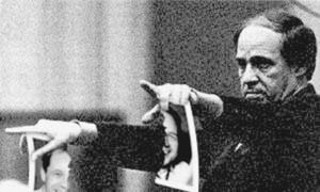The Boulez Project
In concept, the Boulez Project was somewhat provocative, but in performance, it was carelessly assembled
Reviewed by Jerry Young, Fri., March 4, 2005

The Boulez Project
The Church of the Friendly Ghost, Feb. 28
In her June 20, 1971, portrait of Pierre Boulez for The New York Times, Joan Peyser dropped a bomb that, 34 years later, caused her subject a small amount of collateral damage.
The composer of uncompromisingly difficult music had just been appointed music director of the New York Philharmonic. Feeding concertgoers' anxieties, Peyser wrote: "Stravinsky's very recent death does not stop Boulez from criticizing him for using quotations of old music. He concludes [an article in the May 29, 1971, Saturday Review] with a plea for amnesia in composers. (Later he takes off from Stravinsky's use of the past. 'Creators,' he said, 'must look straight ahead. It is not enough to deface the Mona Lisa, because that does not kill the Mona Lisa. All the art of the past must be destroyed.')"
"I'm sure my first thought was that it was a dumb thing to say," said Austin musician Josh Ronsen. "I don't think he meant it literally, but I don't know how he meant it." Ronsen took it at face value for the Boulez Project, in which he and four collaborators destroyed more than 100 items related to Boulez – recordings, books, a DVD – on Monday night.
Ronsen finds it hypocritical that Boulez didn't go far enough. "Bernstein was playing just old favorites, Beethoven and Mozart, what people wanted to hear. I think Boulez was saying you could expect different things from him. His different things were kind of new to people who were used to Mozart and Beethoven, but his focus was on Stravinsky, Wagner, and Berg."
Ronsen took particular offense at a perceived swipe at the 1960s art movement Fluxus and Marcel Duchamp, whose LHOOQ adds a moustache to the world's most famous painting. "Something that is simple like Duchamp's Mona Lisa, he must hate that."
Ronsen admits an element of protest, but distances himself from similar protests. "They wanted the Beatles to leave the planet and the Dixie Chicks to leave the country," Ronsen said. "I'm trying to get people to tell me why this music is important."
As performance, the Boulez Project was carelessly assembled. The concert, which benefited DiverseArts, was scheduled to start at 7pm, but at that time performers were just beginning to set up turntables, CD players, and hand tools. Records and books were broken, torn, and blow-torched, drowning out a performer who was reading notes about Boulez's Le Marteau sans Maitre, reminding us how silly we can look when we break things. Except for the occasionally tasty stray sound, there wasn't much of interest aurally, and there could have been, as John Cage proves in works like Credo in US. This was uninteresting fooling around, like "Revolution 9."
Using old music puts the project squarely in the sights of Boulez's initial criticism of Stravinsky. Does basing art on what one doesn't like from the past differ from swiping from what admires about it?
Last week, Ronsen admitted to having second thoughts: "I don't know if I knew then what I know now that I would do it, but I said I am going to do it, so I am going to go through with it. No one has convinced me not to do it." They would have raised hundreds of dollars for Diverse Arts had they sold the stuff on eBay.
I left with neither the sounds of Boulez nor the Project in my head, instead contemplating how the next-to-last verse of Bob Dylan's "My Back Pages" was apropos of both. "In a soldier's stance I aimed my hand at the mongrel dogs who teach …"










